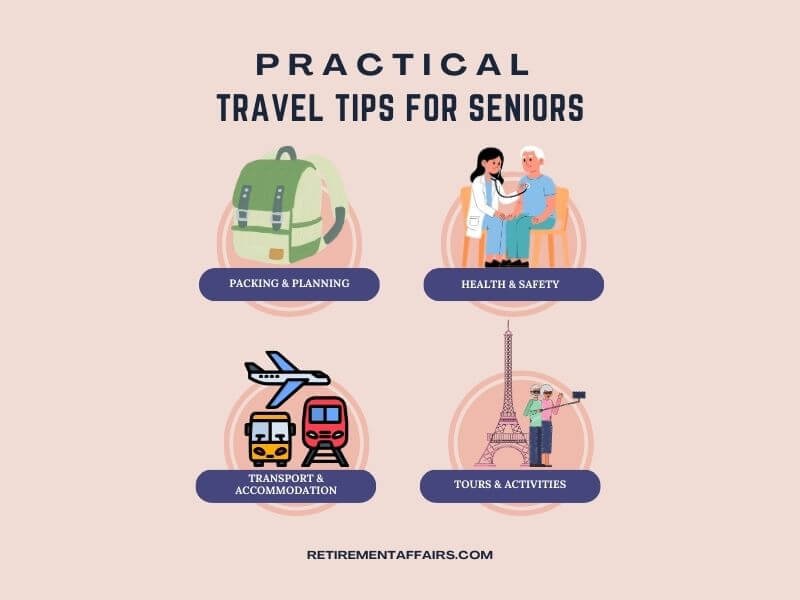Last Updated on: October 24, 2025 by Carlos P. Barry

Travel enriches life at any age, and for many seniors it unlocks joy, social connection, and discovery during a season that often offers more free time and flexibility. Whether it’s strolling through manicured gardens, taking a slow scenic train, or relaxing on an accessible beach, senior friendly travel destinations can be thoughtfully selected to match mobility, health needs, and desired pace. Choosing the right destination means balancing accessibility, healthcare access, comfortable climate, and engaging activities.
This guide helps seniors—and their families or caregivers—pick destinations that prioritize comfort and ease without sacrificing culture, beauty, or adventure. You’ll find destinations across continents, practical accessibility details, the best times to travel, pros and cons, packing and safety tips, a comparison table to quickly review options, and real-world examples to illustrate what a senior-friendly trip can look like. Read on to plan travel that’s as restorative as it is memorable—because excellent travel is timeless.
How to Choose Senior-Friendly Travel Destinations?
Before you pick your next adventure, it’s important to make sure the destination truly fits your needs and comfort level. Here’s a simple checklist to help you decide if a place is right for you:
-
Accessibility: Look for destinations with smooth sidewalks, ramps, elevators, and step-free public transportation. Check if major attractions have wheelchair access, accessible restrooms, and seating areas for breaks.
-
Healthcare Access: Make sure there are nearby hospitals, clinics, and pharmacies—just in case. For peace of mind, research the quality of healthcare and keep emergency contact numbers handy. Check WHO’s Global Health Observatory for healthcare quality data and keep emergency contacts handy.
-
Pace & Mobility Options: Choose places that offer guided tours, hop-on hop-off buses, or wheelchair-friendly excursions so you can explore at your own pace without overexertion.
-
Comfortable Climate: Avoid destinations with extreme heat, humidity, or cold. Aim for mild, pleasant weather during your travel dates so sightseeing stays enjoyable.
-
Safety & Security: Prioritize locations with low crime rates, well-maintained infrastructure, and clear emergency services. You can check official travel advisories before booking. Check official travel advisories via U.S. State Department Travel Advisories or your country’s equivalent.
-
Language & Ease of Communication: Destinations where English is widely spoken—or where you can easily use translation apps—can make travel smoother and less stressful.
-
Cost & Ease of Travel: Consider flight duration, layovers, visa requirements, and time zone changes. Shorter flights and fewer stopovers make trips less tiring and easier on the body.
Check out our post: “8 Essential Travel Safety Tips for Seniors”
💡 Pro Tip: Use this checklist to compare multiple destinations side by side. The right place should match your mobility, comfort preferences, and energy level — so your trip is relaxing, not overwhelming.
Below are 12 senior friendly travel destinations chosen for their accessibility, services, and enjoyable experiences at a gentle pace.
1. Lisbon, Portugal
If you’re dreaming of a European city break filled with charm, history, and gentle seaside breezes, Lisbon is a perfect choice. Known as the “City of Seven Hills,” Lisbon combines old-world architecture with modern accessibility improvements, making it one of the top senior-friendly travel destinations in Europe.

Why It’s Senior-Friendly:
Lisbon’s compact historic neighborhoods, efficient public transit (including trams and elevators), and pedestrian-friendly viewpoints make it easy to explore at a relaxed pace. The mild weather adds to the appeal, allowing for year-round sightseeing without extreme conditions.
Accessibility Info:
Many trams and buses now have low-floor options for easier boarding. Central areas are equipped with elevators and accessible walkways, and recent infrastructure upgrades have made tourist zones far more mobility-friendly.
Best Time to Visit:
Spring (April–June) and fall (September–October) are ideal, with pleasant temperatures and fewer crowds compared to summer.
Pros
- Rich culture with leisurely museums and riverfront promenades
- Good healthcare infrastructure in the city
- More affordable than many Western European capitals
Cons
- Some steep hills and cobblestone streets — plan routes carefully or use taxis/funiculars
- Historic trams are charming but can be crowded during peak hours
Example of Activities:
Take a gentle sunset cruise along the Tagus River or enjoy a tram ride with short walking intervals between sights — perfect for soaking up Lisbon’s atmosphere without overexertion.
Lisbon strikes a beautiful balance between history and convenience, making it a fantastic option for seniors seeking culture, good food, and scenic views without sacrificing accessibility. With a little planning, you can enjoy all the highlights at a pace that feels comfortable and restorative.
Related Read: Best Outdoor Activities for Seniors
2. Kyoto, Japan
Kyoto is where Japan slows down — a city of Zen gardens, centuries-old temples, and serene tea houses. For seniors, Kyoto offers a calm and enriching cultural experience, far from the rush of modern Tokyo.

Why It’s Senior-Friendly:
Kyoto’s slower pace, well-preserved traditions, and guided tours make it ideal for seniors who want meaningful travel without overexertion.
Accessibility Info:
Major temples and gardens provide paved, step-free paths and even wheelchair rentals. Public transport is well-organized with priority seating and accessible stations. Learn about Accessible Tourism in Japan
Best Time to Visit:
Cherry blossom season (late March–April) or autumn foliage (November). Avoid peak weekends if you prefer quieter visits.
Pros
- Tranquil cultural activities (tea ceremonies, garden walks)
- High cleanliness standards and reliable medical care
- Comfortable ryokans (traditional inns) with excellent service
Cons
- Some language barriers in rural areas (translation apps help)
- Peak seasons can be crowded — reserve accessible tours early
Book a small-group guided tour designed for seniors, with short walking routes, teahouse rest breaks, and taxi transfers between sites.
Kyoto is the perfect destination for seniors looking to slow down, immerse themselves in Japanese culture, and experience a journey that’s both peaceful and memorable.
3. Vancouver, Canada
Vancouver is one of the few cities where you can enjoy world-class dining, stroll by the ocean, and see snow-capped mountains — all in the same day. Its flat streets, accessible infrastructure, and easy access to nature make it one of the most senior-friendly travel destinations in North America.

Why It’s Senior-Friendly:
Its walkable downtown, scenic Seawall, and reliable public transit make it easy to explore without needing a car.
Accessibility Info:
Vancouver’s transit is highly accessible, and attractions like Stanley Park, Granville Island, and the Vancouver Aquarium offer ramps, elevators, and visitor support services.
Best Time to Visit:
Summer (June–September) for warm, sunny days perfect for outdoor sightseeing.
Pros
- Flat, beautiful Seawall paths for gentle exercise
- English-speaking, world-class healthcare system
- Range of senior-friendly accommodations with elevators and amenities
Cons
- Shoulder months (Oct–Apr) can be rainy — pack waterproof gear and plan indoor activities
Example of Activities:
Take a leisurely harbor cruise, then enjoy a slow walk through Stanley Park’s accessible trails with frequent rest stops.
Vancouver offers the best of city life and nature in a relaxed, safe, and scenic package — an excellent choice for seniors who want beauty and convenience in one place.
4. Mallorca, Spain
Mallorca is the jewel of Spain’s Balearic Islands, known for its turquoise waters, charming seaside towns, and a pace of life that encourages you to slow down and savor every moment. It’s an ideal destination for seniors looking for a relaxed coastal getaway without the rush of big cities.

Why It’s Senior-Friendly:
This island offers a mix of accessible beaches, scenic drives, and flat promenades, making it easy to enjoy without strenuous activity.
Accessibility Info:
Many beaches are equipped with wheelchair-accessible paths, adapted sunbeds, and assistance services. Ferries and major towns have improved accessibility features for smooth navigation.
Pros
- Gentle-paced island life with plenty of benches along promenades
- Fresh Mediterranean cuisine and leisurely dining culture
Cons
- Some rural roads are narrow and winding — a private driver or accessible guided tour is recommended
Best Time to Visit:
Late spring (May–June) or early fall (September–October) to enjoy warm weather without the peak summer crowds.
Example of Activities:
Spend the morning strolling Palma’s cathedral square, followed by a relaxed coastal drive with scenic stops and a late seaside lunch.
Mallorca is the perfect blend of sea, sun, and slow travel. Its accessible promenades, charming towns, and calm Mediterranean vibe make it an inviting choice for seniors seeking rest and light exploration.
5. Charleston, South Carolina, USA
Charleston is a city that feels like stepping back in time — cobblestone streets, pastel-colored houses, and centuries-old oak trees create a picture-perfect setting. For seniors, it offers a gentle pace of life, excellent hospitality, and an abundance of cultural experiences that don’t require strenuous activity.

Why It’s Senior-Friendly:
Charleston’s historic district is largely flat and easy to navigate, making it ideal for walking tours, carriage rides, and leisurely afternoons exploring art galleries or waterfront parks.
Accessibility Info:
Many historic sites and museums provide ramps and accessible tours, and downtown streets are stroller- and wheelchair-friendly.
Best Time to Visit:
Fall (October–November) or spring (March–May), when the weather is mild and gardens are in full bloom.
Pros
- Flat, walkable historic district with plenty of benches for rest
- Welcoming hospitality industry with senior-focused travel packages
Cons
- Humid and hot during summer — best to avoid peak heat months
Example of Activities:
Take a guided carriage ride through the historic district, enjoy a relaxing waterfront lunch, and explore a plantation garden at your own pace.
Charleston is a wonderful destination for seniors seeking a mix of history, hospitality, and slow-paced charm. With its accessible streets, friendly locals, and year-round cultural events, it’s perfect for a laid-back but enriching getaway.
YOU CAN ALSO READ : Best Bus Tours for Seniors
6. New Zealand
If you’ve ever dreamed of dramatic mountain vistas, crystal-clear lakes, and charming small towns, New Zealand’s South Island is a dream destination. Known for its natural beauty and friendly locals, this region is perfect for seniors who want to experience world-class scenery without strenuous hiking.

Why It’s Senior-Friendly:
The South Island offers some of the world’s most breathtaking landscapes that can be easily enjoyed from accessible viewpoints, car routes, or short guided excursions — no intense trekking required.
Accessibility Info:
Most major attractions, including national parks and lookouts, provide wheelchair-friendly pathways and ramps. Many excursion companies offer adapted vehicles and personalized itineraries for travelers with mobility needs. Check 100% Pure New Zealand Accessible Travel Guide
Best Time to Visit:
Spring (September–November) and fall (March–May) for mild weather, fewer crowds, and vibrant seasonal colors.
Pros
- Stunning views accessible by car, cable car, or short walks
- Senior-friendly travel packages and helpful tourism providers
Cons
- Long flights — plan rest days for jet lag recovery
Example of Activities:
Take a scenic drive along Lake Wakatipu in Queenstown, followed by a leisurely boat cruise through Milford Sound — a breathtaking way to enjoy the fjords without physical strain.
New Zealand’s South Island is a bucket-list destination that’s surprisingly accessible for seniors. With a little planning, you can experience its epic landscapes at a comfortable pace, making it the ultimate combination of adventure and relaxation.
7. Amalfi Coast, Italy
The Amalfi Coast is one of Italy’s most iconic destinations, famous for its colorful cliffside towns, sparkling Mediterranean waters, and mouthwatering cuisine. For seniors, it offers an opportunity to experience breathtaking coastal scenery without needing to climb steep staircases — as long as you choose the right base.

Why It’s Senior-Friendly:
Sorrento is the ideal base for seniors because it’s relatively flat, well-connected, and easier to navigate compared to other Amalfi towns. From here, you can take scenic ferry rides, enjoy leisurely meals with sea views, and take day trips to Positano, Amalfi, or Capri without rushing.
Accessibility Info:
Ferries between towns provide step assistance, and key areas have ramps and elevators to help minimize strenuous walking. Taxis and private drivers are readily available for comfortable transfers.
Best Time to Visit:
Late spring (May–June) or early fall (September–October) to avoid the heavy summer crowds and heat.
Pros
- Scenic drives and boat rides reduce the need for walking
- World-class Italian dining, wine, and private tours for a slow-travel experience
Cons
- Many small towns still have steep steps — planning excursions from an accessible base is essential
Example of Activities:
Spend a morning exploring Sorrento’s charming piazzas, take a ferry to Positano for a seaside lunch, and return by sunset without overexertion.
The Amalfi Coast can be as relaxing or adventurous as you want it to be. With Sorrento as your home base, you’ll enjoy the coast’s beauty, culture, and cuisine at a senior-friendly pace — no endless stair climbing required.
8. Singapore
Singapore is a world-class city where modern design meets lush greenery, making it a favorite destination for seniors seeking a stress-free urban getaway. Everything is well-organized, from transportation to healthcare, making travel here smooth and worry-free.

Why It’s Senior-Friendly:
This city-state is incredibly accessible, with wheelchair-friendly public transport, clear signage, and plenty of indoor attractions to escape the heat or rain. Its compact size allows you to see and do a lot without long travel times between stops.
Accessibility Info:
All MRT (metro) stations and buses are wheelchair-accessible, and major attractions such as Gardens by the Bay, Marina Bay Sands, and museums feature ramps, elevators, and well-marked accessible routes.
Best Time to Visit:
Singapore is a year-round destination, though if you want less rain, avoid the wettest months (November–January).
Pros
- Excellent English-language support makes communication easy
- Clean, safe, and highly organized city with many shaded or sheltered walkways
Cons
- Tropical humidity — plan breaks in air-conditioned cafés or malls to stay comfortable
Example of Activities:
Stroll through Gardens by the Bay in the morning, enjoy a leisurely lunch at a hawker center, and take a river cruise in the evening for a relaxing way to see the skyline.
Singapore is a stress-free choice for senior travelers, offering a mix of culture, nature, and comfort in a compact, highly accessible setting. Whether it’s your first international trip or a stopover on a longer journey, this city makes travel easy and enjoyable.
9. Tuscany, Italy
Tuscany is the heart of Italy’s culture, known for its Renaissance art, picturesque vineyards, and gently rolling hills. For seniors, this region offers the perfect chance to slow down, savor world-class wine and food, and enjoy beautiful landscapes at a comfortable pace.

Why It’s Senior-Friendly:
Florence makes an excellent base with its accessible museums, guided city tours, and easy connections to nearby towns. Day trips to the countryside allow you to enjoy vineyard tastings, cooking classes, and scenic drives without overexertion.
Accessibility Info:
Florence’s major museums have ramps, elevators, and wheelchair rental options. Many wineries and agriturismos provide accessible tasting rooms and seating areas.
Best Time to Visit:
Spring (April–June) and autumn (September–October) offer mild weather, fewer crowds, and breathtaking scenery.
Pros
- Ideal for slow travel, with short drives and seated cultural experiences
- Culinary activities can be adapted to dietary needs and mobility levels
Cons
- Some historic areas have uneven cobblestone streets — plan routes carefully or use guided tours for convenience
Example of Activities:
Spend a morning at the Uffizi Gallery with a guided accessible tour, enjoy a long lunch at a countryside winery, and return to Florence for a relaxing evening stroll.
Tuscany is a feast for the senses and a dream for seniors who love art, food, and relaxed travel. With careful planning, you can enjoy the region’s highlights without rushing, making it an unforgettable experience.
10. Reykjavik, Iceland
Reykjavik, Iceland’s charming capital, offers a unique blend of urban comfort and easy access to breathtaking natural wonders. For seniors, it’s an ideal destination to explore geothermal pools, volcanic landscapes, and cultural sites without long, strenuous treks.

Why It’s Senior-Friendly:
The city is compact and easy to navigate, with accessible attractions, guided tours, and services tailored to travelers with limited mobility. Iceland’s emphasis on safety and healthcare adds an extra layer of confidence for senior visitors.
Accessibility Info:
Many tour operators provide accessible transportation, while popular attractions like the Blue Lagoon feature ramps, lifts, and adapted changing rooms. Drive-and-view tours allow minimal walking while still experiencing Iceland’s dramatic scenery.
Best Time to Visit:
Summer (June–August) offers long daylight hours and milder temperatures, making sightseeing more comfortable and accessible.
Pros
- Stunning natural landscapes accessible with minimal walking
- High standards of healthcare and safety throughout the city
Cons
- Weather can be unpredictable — layering is essential for comfort
Example of Activities:
Take a drive along the Golden Circle, stopping at geysers and waterfalls, then relax in the Blue Lagoon’s accessible geothermal pools for a restorative afternoon.
Reykjavik combines incredible natural beauty with senior-friendly accessibility. With proper planning, seniors can enjoy Iceland’s unforgettable landscapes, thermal waters, and culture without physical strain.
11. Savannah, Georgia, USA
Savannah is a picturesque city steeped in history, with moss-draped oaks, cobblestone squares, and a relaxed Southern atmosphere. Seniors can enjoy its charm at a leisurely pace, taking in cultural sites and scenic riverfronts without strenuous activity.

Why It’s Senior-Friendly:
The city’s flat historic districts and well-maintained pathways make strolling or taking a carriage/trolley tour easy. Many attractions accommodate visitors with limited mobility, ensuring a comfortable visit.
Accessibility Info:
Historic homes, museums, and guided tours often provide accessible entries, ramps, and seating options. Trolley and carriage tours allow exploration with minimal walking.
Best Time to Visit:
Spring (March–May) and fall (September–November) offer mild temperatures and pleasant outdoor conditions.
Pros
- Slow-paced, shaded streets with plenty of benches
- Warm Southern hospitality and senior-friendly accommodations
Cons
- Summers can be hot and humid; plan indoor breaks and rest periods
Example of Activities:
Enjoy a guided trolley tour through Savannah’s historic squares, followed by a relaxing riverside lunch at a café with shaded seating.
Savannah is ideal for seniors who want a blend of history, culture, and leisurely exploration. Its accessible streets, welcoming atmosphere, and gentle pace make it a memorable and stress-free travel destination.
12. Cape Town, South Africa
Cape Town is a vibrant city framed by mountains, oceans, and vineyards, offering seniors a mix of natural beauty, culture, and relaxation. Its iconic landmarks and accessible attractions make it a perfect destination for travelers who want variety without overexertion.

Why It’s Senior-Friendly:
The city provides easy access to panoramic vistas, beaches, and scenic drives, along with reliable private tour options and medical facilities that give peace of mind to older travelers.
Accessibility Info:
The Table Mountain cable car offers step-free access and breathtaking views, while many private tours provide accessible vehicles. Selected beaches and wineries also accommodate limited mobility.
Best Time to Visit:
Late spring to early autumn (October–March) offers pleasant weather for outdoor sightseeing and scenic drives.
Pros
- Wide range of accessible activities, from scenic drives to seated wine tastings
- High-quality private transport options and top-tier medical facilities
Cons
- Some areas require caution for safety — stick with reputable tours and accommodations
Example of Activities:
Take the Table Mountain cable car for stunning views, followed by a relaxed afternoon visiting a vineyard with accessible tasting rooms.
Cape Town combines breathtaking scenery, cultural experiences, and senior-friendly accessibility. With thoughtful planning, seniors can enjoy its diversity comfortably, creating a memorable and stress-free adventure.
Comparison Table — Quick at-a-glance
Destination | Accessibility Highlights | Best Season | Ideal For |
Lisbon | Accessible trams & elevators in tourist areas | Spring/Fall | City walks, river views |
Kyoto | Paved temple paths, accessible trains | Spring/Fall | Culture & gardens |
Vancouver | Seawall promenades, accessible transit | Summer | Nature + city |
Mallorca | Accessible beaches & promenades | Spring/Fall | Relaxing coastal stay |
Charleston | Flat historic district, museums | Spring/Fall | History & food |
New Zealand (Sth) | Accessible viewpoints & tours | Spring/Fall | Scenic drives |
Amalfi Coast | Ferries & coastal views, base in Sorrento | Spring/Fall | Coastal scenery |
Singapore | Excellent accessibility & healthcare | Year-round | Comfort + gardens |
Tuscany | Accessible museums & wineries | Spring/Fall | Food & art |
Reykjavik | Accessible geothermal pools & tours | Summer | Natural sights |
Savannah | Trolley tours & flat streets | Spring/Fall | Leisurely historic walks |
Cape Town | Cable car & accessible tours | Oct–Mar | Scenic & wine tours |
Practical travel tips for seniors

Packing & planning
- Carry essential documents in both print and digital form: passport, travel insurance, medication list, emergency contacts.
- Pack a medical kit: regular meds (in original containers), a list of allergies, bandages, antiseptic, and a copy of prescriptions.
- Lightweight mobility aids: If you use a cane or rollator, consider portable, foldable models or renting at the destination.
- Comfortable shoes and layered clothing for changing conditions.
Health & safety
- Get travel insurance that covers pre-existing conditions and local medical evacuation if needed.
- Plan rest days—avoid scheduling back-to-back long excursions.
- Check medication rules for countries you visit; some medicines require declarations.
- Keep hydration and sun protection in mind, especially in hot climates.
Transport & accommodation
- Request accessible rooms and ground-floor or elevator-accessible rooms when booking.
- Pre-arrange airport assistance (meet-and-greet, wheelchair service) if needed.
- Prefer shorter transfers between hotels and attractions; use taxis or private transfers for convenience.
Tours & activities
- Choose small-group or private tours that allow breaks and adjustable pacing.
- Look for “senior-friendly” or “accessible” labels when booking excursions.
- Use hop-on hop-off buses in cities for flexible sightseeing with minimal walking.
Illustrative case studies (short, practical examples)
Case study 1 — Two-week gentle Portugal trip
Mrs. Sabina Patin, 72, wanted a calm cultural vacation with minimal walking. She flew into Lisbon, booked a centrally located accessible hotel, used tram/elevator options for short sightseeing, and took a private day trip to Sintra (driver provided). She scheduled a 3-night stay in the Algarve where a beachfront promenade and accessible beach facilities allowed daily strolls. The trip balanced sightseeing with long rest breaks and easy transport.
Case study 2 — Japan with limited mobility
Mr. Robert Hall, 68, uses a folding wheelchair. He based his stay in Kyoto, booked accessible temple visits through a local operator that provided ramps and short walking routes, and used taxis to limit transfers. His itinerary included a private tea ceremony in a garden with paved paths and a slow, scenic train ride to another city with accessible stations.
Activities & Experiences That Work Well for Seniors
Travel isn’t just about destinations — it’s about the experiences that make a trip memorable. For seniors, choosing activities that combine enjoyment with comfort and accessibility is key. From scenic drives to cultural tours, there are plenty of ways to explore without overexertion.
Recommended Activities:
- Scenic drives and train journeys: Comfortable travel options that allow you to enjoy stunning landscapes without long walks.
- River and coastal cruises: Gentle cruises with accessible cabins, dining, and sightseeing.
- Guided cultural tours: Short walking segments with frequent rest stops for museums, gardens, or historical sites.
- Food and wine experiences: Seated tastings and culinary tours tailored for relaxed enjoyment.
- Spa and wellness retreats: Accessible facilities for relaxation and rejuvenation.
- City sightseeing buses: Hop-on hop-off buses reduce walking while allowing flexible exploration of urban highlights.
Suggested Read: Sit-Down Games and Indoor Activities for Seniors
Accessibility Checklist Before You Book
Ensuring accessibility is a key part of planning a senior-friendly trip. Before finalizing your travel plans, use this checklist to confirm that your accommodations, transport, and activities meet your mobility and comfort needs.
Key Questions to Consider:
-
Are hotel entrances and rooms wheelchair accessible?
-
Does the hotel have step-free access to main amenities like restaurants, pools, and elevators?
-
Can the airline or airport provide wheelchair assistance if needed?
-
Are the main attractions you want to visit accessible for limited mobility?
-
Is public transportation adapted to your mobility requirements?
-
Do local healthcare facilities meet your standards for emergencies or ongoing care?
-
Does your travel insurance cover your medical needs abroad, including pre-existing conditions?
Tip:
If you answer “no” to several of these questions, consider changing your destination or arranging private transport and tours that accommodate your needs. Proper planning ensures a safe, comfortable, and enjoyable trip. Visit WheelchairTravel.org for destination-specific accessibility reviews.
Frequently Asked Questions (FAQs)
1. What makes a destination “senior friendly”?
A senior friendly travel destination prioritizes safety, accessibility, healthcare access, comfortable climate, easy transport, and activities with flexible pacing. It should allow older travelers to enjoy attractions without excessive physical strain.
2. How can I find accessible accommodations?
When booking, filter for “accessible rooms” on hotel websites and major booking platforms. Call the property directly to confirm elevator access, roll-in showers, and proximity to attractions. Request floor plans or photos if needed.
3. Do I need special travel insurance as a senior?
Yes—get travel insurance that explicitly covers pre-existing conditions, emergency medical care, and medical evacuation. Compare providers for senior-specific policies with appropriate coverage limits.
4. Are cruises a good option for seniors?
Cruises can be excellent because they offer onboard medical facilities, accessible cabins, no need to repack frequently, and opportunities for shore excursions with low walking demands. Choose ships with elevators and accessible shore excursion options.
5. How do I manage medication while traveling internationally?
Carry medications in original labeled containers, pack a doctor’s note and prescription list, and keep medicines in your carry-on. Research local rules for controlled medications and bring an adequate supply for the trip plus a few extra days.
6. Are group tours a good idea for seniors?
Yes—group tours designed for seniors or small private tours can be ideal since they offer paced itineraries, built-in assistance, transportation, and the social benefits of traveling with peers.
Senior travel is not a different kind of travel—it’s travel shaped by comfort, safety, and intention. With a little planning and the right destinations, older adults can enjoy vibrant, accessible, and deeply rewarding journeys. Use this guide to pick senior friendly travel destinations that match your mobility, interests, and energy level—and then set out to make memories that last a lifetime.😊
YOU CAN ALSO READ :
*Best 15 Hobbies for Elderly at Home to Keep Them Busy and Happy
*15+ Fun and Safe Beach Games for Seniors to Stay Active, Social, and Healthy




